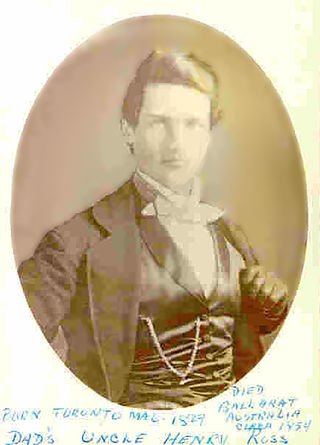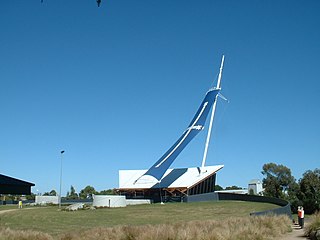The Eureka Rebellion was a series of events on the Victorian goldfields from 1851 to 1854. It culminated in the Battle of the Eureka Stockade fought between miners and the colonial forces of Australia at Ballarat on 3 December 1854.
Eureka Rebellion may also refer to:

The Eureka Rebellion was a series of events involving gold miners who revolted against the British colonial government in Victoria, Australia during the Victorian gold rush. It culminated in the Battle of the Eureka Stockade, which took place on 3 December 1854 at Ballarat between the rebels and the colonial forces of Australia. The fighting left at least 27 dead and many injured, most of the casualties being rebels. There was a preceding period beginning in 1851 of peaceful demonstrations and civil disobedience on the Victorian goldfields. The miners, many of whom such as Raffaello Carboni came from Europe and were veterans of the Revolutions of 1848, had various grievances, chiefly the cost of mining permits and the officious way the system was enforced.
Eureka often refers to:

The Eureka Flag was flown at the Battle of the Eureka Stockade, which took place on 3 December 1854 at Ballarat in Victoria, Australia. It was the culmination of the 1851–1854 Eureka Rebellion on the Victorian goldfields. Gold miners protested the cost of mining permits, the officious way the colonial authorities enforced the system, and other grievances. An estimated crowd of over 10,000 demonstrators swore allegiance to the flag as a symbol of defiance at Bakery Hill on 29 November 1854. It was then flown over the Eureka Stockade during the battle that resulted in at least 27 deaths. Around 120 miners were arrested, and many others were badly wounded, including 5 soldiers.

Peter Fintan Lalor was an Irish-Australian rebel and, later, politician who rose to fame for his leading role in the Eureka Rebellion, an event identified with the "birth of democracy" in Australia.

John Basson Humffray was a leading advocate in the movement of miner reform process in the British colony of Victoria, and later a member of parliament.

Henry Ross was a Canadian-Australian gold miner who died in the Eureka Rebellion at the Ballarat gold fields in the British Colony of Victoria, now the state of Victoria in Australia. Ross is particularly remembered for his part in the creation of the rebel miners' flag, since named the Eureka Flag.

Eureka Stockade is a 1949 British film of the story surrounding Irish-Australian rebel and politician Peter Lalor and the gold miners' rebellion of 1854 at the Eureka Stockade in Ballarat, Victoria, in the Australian Western genre.

The Ballarat Reform League came into being in October 1853 and was officially constituted on 11 November 1854 at a mass meeting of miners in Ballarat, Victoria to protest against the Victorian government's mining policy and administration of the goldfields.

Eureka is a small eastern suburb of Ballarat, Victoria, Australia. It was originally part of Ballarat East but became its own suburb in 1946 in recognition of the area's significance to Australian history. Eureka is bordered by Specimen Creek to the north, Canadian Creek to the south, Queen and Joseph streets to the west and Kline and Stawell Street to the east. The suburb takes its name from the Eureka Lead – a lead is an ancient river bed that contains gold – of the Eureka Mining Company and is most notable as the site of the historic event of the Eureka Rebellion. This was the site where the rebel miners flew the Eureka Flag for the first time; a flag that has since become a symbol of the working class and trade union movement and, at times, Australian republicanism.

Eureka Stockade is a 1907 Australian silent film about the Eureka Rebellion. It was the second feature film made in Australia, following The Story of the Kelly Gang.

The Battle of the Eureka Stockade was fought in Ballarat, Victoria, Australia on 3 December 1854, between gold miners and the colonial forces of Australia. It was the culmination of the 1851–1854 Eureka Rebellion during the Victorian gold rush. The fighting resulted in at least 27 deaths and many injuries, the majority of casualties being rebels. The miners had various grievances, chiefly the cost of mining permits and the officious way the system was enforced.
The Eureka Rebellion was a series of events on the Victorian goldfields from 1851 to 1854. It culminated in the Battle of the Eureka Stockade fought between miners and the colonial forces of Australia at Ballarat on 3 December 1854.

Since 2012, various theories have emerged, based on the Argus account of the Battle of the Eureka Stockade and an affidavit sworn by Private Hugh King three days later as to a flag being seized from a prisoner detained at the stockade, concerning whether a Union Jack, known as the Eureka Jack was also flown by the rebel garrison. Readers of the Argus were told that:
The flag of the diggers, "The Southern Cross," as well as the "Union Jack," which they had to hoist underneath, were captured by the foot police.
The following bibliography includes notable sources concerning the Eureka Rebellion. This article is currently being expanded and revised.

Edward Thonen was a German emigrant to Australia, and one of the miners involved in the Eureka Rebellion in Ballarat, Victoria. He was captain of one of the miners' divisions. When soldiers stormed the Stockade on 3 December 1854, Thonen was one of the first to be killed in the Battle of the Eureka Stockade.

The Eureka Rebellion, an 1854 gold miner's revolt in Victoria, Australia, has been the inspiration for numerous novels, poems, films, songs, plays and artworks. Much of Eureka folklore relies heavily on Raffaello Carboni's 1855 book, The Eureka Stockade, which is the first and only comprehensive eyewitness account of the uprising. The poet Henry Lawson wrote about Eureka, as have many novelists.

There were key people involved in the Eureka Rebellion who subscribed to the ideals of Chartism and saw the struggle on the Victorian goldfields as a continuation of the activism in Britain in the 1840s and "the centuries of heroic struggles in England which preceded the Australian Federation" such as the 1688 Glorious Revolution, that resulted in the enactment of the English Bill of Rights. From 1837 to 1848, 129,607 incomers to Australia arrived from the British mainland, with at least 80 "physical force" chartists sentenced to penal servitude in Van Diemens Land. Currey agrees that the population at the time would have been sufficiently politically awake such that: "it may be fairly assumed that the aims of the Anti-Corn-Law League and the Chartists were very familiar to many of the Victorian miners".

The Eureka Stockade was a crude battlement built in 1854 by rebel gold miners at Ballarat, Australia during the Eureka Rebellion. It stood from 30 November until the Battle of the Eureka Stockade on 3 December. The exact dimensions and location of the stockade are a matter of debate among scholars. There are various contemporary representations of the Eureka Stockade, including the 1855 Victorian high treason trials map and Eureka Slaughter by Charles Doudiet.

The Victorian gold rush led to an influx of foreign nationals, increasing the colony's population from 77,000 in 1851 to 198,496 in 1853. Many such as Raffaello Carboni had experienced the Revolutions of 1848. They supported the protest movement that formed on the goldfields in opposition to the mining tax system, ultimately leading to an armed uprising at Ballarat. It is currently known that the participants in the Battle of the Eureka Stockade on 3 December 1854 came from at least 23 different nations, including Australia, Canada, the United States of America, Jamaica, Mauritius, Russia, Norway, Finland, Sweden, Denmark, Poland, Switzerland, Italy, Greece, The Netherlands, Scotland, Ireland, England, Wales, Germany, France, Portugal and Spain. Carboni recalled that "We were of all nations and colours." During the 1855 Victorian high treason trials, the Argus court reporter observed that of "the first batch of prisoners brought up for examination, the four examined consisted of one Englishman, one Dane, one Italian, and one negro, and if that is not a foreign collection, we do not know what is." However, despite being present on the Ballarat gold fields, there is no record of any Chinese involvement at the Eureka Stockade. According to figures published by Professor Anne Beggs-Sunter, in her sample of 44 rebels, only one hailed from a non-European country.

The vexillological aspects of the Eureka Rebellion include the Eureka Flag and others used in protest on the goldfields and those of the British Army units at the Battle of the Eureka Stockade. The disputed first report of the attack on the Eureka Stockade also refers to a Union Jack, known as the Eureka Jack, being flown during the battle that was captured, along with the Eureka Flag, by the foot police.